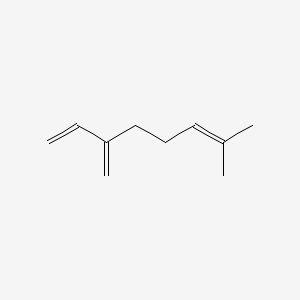| Authors | Title | Published | Journal | PubMed Link |
|---|---|---|---|---|
| Rivoal A et al. | Environmental control of terpene emissions from Cistus monspeliensis L. in natural Mediterranean shrublands. | 2010 | Chemosphere | pmid:20092868 |
| Salthammer T et al. | Formaldehyde in the indoor environment. | 2010 | Chem. Rev. | pmid:20067232 |
| Lu H et al. | Variation in chemical composition and antibacterial activities of essential oils from two species of Houttuynia THUNB. | 2006 | Chem. Pharm. Bull. | pmid:16819207 |
| Fischedick J et al. | Cannabinoid receptor 1 binding activity and quantitative analysis of Cannabis sativa L. smoke and vapor. | 2010 | Chem. Pharm. Bull. | pmid:20118579 |
| Kuo YH et al. | Novel diterpenes from the heartwood of Chamaecyparis obtusa var. formosana. | 2004 | Chem. Pharm. Bull. | pmid:15187404 |
| Bonamin F et al. | The effect of a minor constituent of essential oil from Citrus aurantium: the role of β-myrcene in preventing peptic ulcer disease. | 2014 | Chem. Biol. Interact. | pmid:24480520 |
| Usta J et al. | Linalool decreases HepG2 viability by inhibiting mitochondrial complexes I and II, increasing reactive oxygen species and decreasing ATP and GSH levels. | 2009 | Chem. Biol. Interact. | pmid:19428344 |
| Nikolić B et al. | Variability of the needle essential oils of Pinus heldreichii from different populations in Montenegro and Serbia. | 2007 | Chem. Biodivers. | pmid:17510986 |
| Flamini G and Cioni PL | Seasonal variation of the chemical constituents of the essential oil of Santolina etrusca from Italy. | 2007 | Chem. Biodivers. | pmid:17510997 |
| Ponzoni C et al. | Biotransformation of acyclic monoterpenoids by Debaryomyces sp., Kluyveromyces sp., and Pichia sp. strains of environmental origin. | 2008 | Chem. Biodivers. | pmid:18357555 |
| Esmaeili A and Hashemi E | Biotransformation of myrcene by Pseudomonas aeruginosa. | 2011 | Chem Cent J | pmid:21609445 |
| El Amine Dib M et al. | Characterization of volatile compounds of Daucus crinitus Desf. Headspace Solid Phase Microextraction as alternative technique to Hydrodistillation. | 2010 | Chem Cent J | pmid:20858266 |
| Paumgartten FJ et al. | Single dose toxicity study of beta-myrcene, a natural analgesic substance. | 1990 | Braz. J. Med. Biol. Res. | pmid:2101331 |
| da-Silva VA et al. | Neurobehavioral study of the effect of beta-myrcene on rodents. | 1991 | Braz. J. Med. Biol. Res. | pmid:1797273 |
| Zamith HP et al. | Absence of genotoxic activity of beta-myrcene in the in vivo cytogenetic bone marrow assay. | 1993 | Braz. J. Med. Biol. Res. | pmid:8220273 |
| Freitas JC et al. | Effect of beta-myrcene on pentobarbital sleeping time. | 1993 | Braz. J. Med. Biol. Res. | pmid:8257941 |
| Paumgartten FJ et al. | Study of the effects of beta-myrcene on rat fertility and general reproductive performance. | 1998 | Braz. J. Med. Biol. Res. | pmid:9698761 |
| Russo EB | Taming THC: potential cannabis synergy and phytocannabinoid-terpenoid entourage effects. | 2011 | Br. J. Pharmacol. | pmid:21749363 |
| Martin DM et al. | Functional annotation, genome organization and phylogeny of the grapevine (Vitis vinifera) terpene synthase gene family based on genome assembly, FLcDNA cloning, and enzyme assays. | 2010 | BMC Plant Biol. | pmid:20964856 |
| Keeling CI et al. | Transcriptome mining, functional characterization, and phylogeny of a large terpene synthase gene family in spruce (Picea spp.). | 2011 | BMC Plant Biol. | pmid:21385377 |
Myrcene
Myrcene is a lipid of Prenol Lipids (PR) class. Myrcene is associated with abnormalities such as Hypomenorrhea, abnormal fragmented structure, Nephrosis, Renal tubular disorder and Kidney Diseases. The involved functions are known as Anabolism, Gene Expression, Protein Biosynthesis, Mutation and Selection, Genetic. Myrcene often locates in Plastids, Proboscis, Body tissue, Clone and soluble. The associated genes with Myrcene are TTPA gene, monoterpene synthase, Genome, 4S-limonene synthase and Homologous Gene. The related lipids are Pinene, Octanols, Membrane Lipids and Fatty Acids, Unsaturated.
Cross Reference
Introduction
To understand associated biological information of Myrcene, we collected biological information of abnormalities, associated pathways, cellular/molecular locations, biological functions, related genes/proteins, lipids and common seen animal/experimental models with organized paragraphs from literatures.
What diseases are associated with Myrcene?
Myrcene is suspected in Nephrosis, Kidney Diseases, Dehydration, Hypomenorrhea, Renal tubular disorder and other diseases in descending order of the highest number of associated sentences.
Related references are mostly published in these journals:
| Disease | Cross reference | Weighted score | Related literature |
|---|
No disease MeSH terms mapped to the current reference collection.
PubChem Associated disorders and diseases
What pathways are associated with Myrcene
There are no associated biomedical information in the current reference collection.
PubChem Biomolecular Interactions and Pathways
Link to PubChem Biomolecular Interactions and PathwaysWhat cellular locations are associated with Myrcene?
Visualization in cellular structure
Associated locations are in red color. Not associated locations are in black.
Related references are published most in these journals:
| Location | Cross reference | Weighted score | Related literatures |
|---|
What functions are associated with Myrcene?
Related references are published most in these journals:
| Function | Cross reference | Weighted score | Related literatures |
|---|
What lipids are associated with Myrcene?
Related references are published most in these journals:
| Lipid concept | Cross reference | Weighted score | Related literatures |
|---|
What genes are associated with Myrcene?
Related references are published most in these journals:
| Gene | Cross reference | Weighted score | Related literatures |
|---|
What common seen animal models are associated with Myrcene?
There are no associated biomedical information in the current reference collection.
